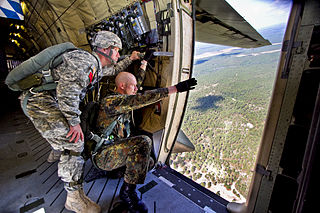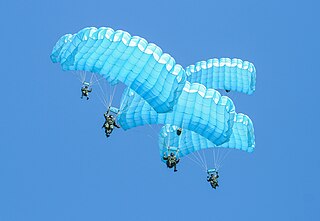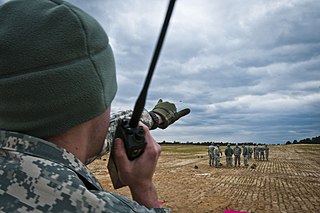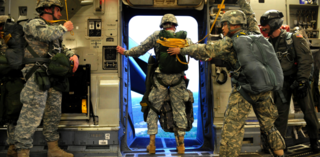
High-altitude military parachuting, or military free fall (MFF), is a method of delivering military personnel, military equipment, and other military supplies from a transport aircraft at a high altitude via free-fall parachute insertion. Two techniques are used: HALO and HAHO.

The Parachute Rigger Badge is a military qualification badge of the United States Army and the United States Air Force which was first created in 1948 and officially approved in June 1986. The award is intended as a badge for enlisted, warrant officer and officer personnel who have successfully completed parachute rigger courses specified by the U.S. Army Quartermaster Center and School.

A parachutist badge is a badge awarded by armed forces or paramilitary forces of many states to personnel who have received parachute training and completed the required number of jumps. It is difficult to assess which country was the first to introduce such an award.

The Parachutist Badge, also commonly referred to as "Jump Wings", is a military badge of the United States Armed Forces. Some services, such as the Marine Corps, officially refer to it as an insignia instead of a badge. The United States Space Force and United States Coast Guard are the only branches that do not award the Parachutist Badge, but their members are authorized to receive the Parachutist Badges of other services in accordance with their prescribed requirements. The DoD military services are all awarded the same Military Parachutist Badge. The U.S. Army and U.S. Air Force issue the same Senior and Master Parachutist Badges while the U.S. Navy and U.S. Marine Corps issue the Navy and Marine Corps Parachutist Insignia to advanced parachutists. The majority of the services earn their Military Parachutist Badge through the U.S. Army Airborne School.

The United States Army Airborne School—widely known as Jump School—conducts the basic paratrooper training for the United States Armed Forces. It is operated by the 1st Battalion (Airborne), 507th Infantry, United States Army Infantry School, Fort Moore, Georgia. The Airborne School conducts the Basic Airborne Course, which is open to troops from all branches of the United States Department of Defense, Reserve Officer Training Corps, and allied military personnel.

A static line is a fixed cord attached to a large, stable object. It is used to open parachutes automatically for paratroopers and novice parachutists.
A parachute rigger is a person who is trained or licensed to pack, maintain or repair parachutes. A rigger is required to understand fabrics, hardware, webbing, regulations, sewing, packing, and other aspects related to the building, packing, repair, and maintenance of parachutes.

The United States Army Parachute Team, nicknamed the Golden Knights, is a demonstration and competition parachute team of the United States Army. It consists of demonstration and competition parachutist teams, drawn from all branches of the U.S. Army. Members must demonstrate excellence in parachuting.

Jumpmasters are the expert paratroopers in an airborne unit who train and teach the military techniques for jumping from airplanes. They are responsible for training soldiers who enter Army Airborne School into paratroopers and managing airborne jump operations in airborne units across all branches of services.

James C. Yarbrough is a retired brigadier general in the United States Army.

The 98th Flying Training Squadron is a United States Air Force unit assigned to the 306th Flying Training Group. It is stationed at the United States Air Force Academy, Colorado, however its De Havilland Canada UV-18 Twin Otter aircraft are housed and maintained at nearby Peterson Air Force Base, Colorado.

Parachuting and skydiving is a method of transiting from a high point in an atmosphere to the ground or ocean surface with the aid of gravity, involving the control of speed during the descent using a parachute or parachutes.

The Esquadrão Aeroterrestre de Salvamento (EAS), known by its nickname Para-SAR, is a Brazilian Air Force special operations search and rescue squadron, based in the city of Campo Grande.
A SOT-A is a signals intelligence–electronic warfare (SIGINT-EW) element of the United States Army Special Forces.

The RA-1 Military Free-Fall Advanced Ram-Air Parachute System provides a multi-mission, high-altitude parachute delivery system that allows personnel to exit at altitudes between 3,500 feet and 35,000 feet. The parachute, which replaces the current MC-4 parachute, supports a total jumper weight of 450 pounds. It also provides non-MFF personnel with a ram-air parachute that is static-line deployed.

The United States Army Maneuver Center of Excellence Command Exhibition Parachute Team, commonly known as the Silver Wings, is the official demonstration parachute team of Fort Benning, Georgia, United States Army. It is made up of US Army Paratroopers who have demonstrated excellence in parachuting skills, drawn primarily from the 1st Battalion of the 507th Parachute Infantry Regiment, Fort Benning.

The United States Army Pathfinder Course trains military personnel in the U.S. Army and its sister services to set up parachute drop zones and helicopter landing zones for airborne and air assault missions.

The United States Army Jumpmaster School trains personnel in the skills necessary to jumpmaster a combat-equipped jump and the proper attaching, jumping, and releasing of combat and individual equipment while participating in an actual jump that is proficient in the duties and responsibilities of the Jumpmaster and Safety; procedures for rigging individual equipment containers and door bundles; personnel parachute components by their specific nomenclature and characteristics; procedures and standards required to conduct a JumpMaster Personnel Inspection (JMPI); the duties and responsibilities of the Drop Zone Safety Officer; the presentation of the Jumpmaster briefing and sustained airborne training (SAT); and the execution of the duties of a Jumpmaster and Safety from a USAF aircraft during a day/night combat equipment jump.

The British Armed Forces award a range of Parachutist Badges to those qualified as military parachutists. The version awarded depends largely on the unit or role that the individual fills following qualification.

Aircrew survival equipmentmen are survival equipment specialists and certified parachute riggers who oversee valuable life saving equipment, parachutes, and other special gear used by U.S. Naval and Marine Corps special operations forces, Naval Air Department, and the United States Navy Parachute Team known as the "Leap Frogs". They perform a wide range of duties, which include inspecting, maintaining, and repairing parachutes, search and rescue equipment, along with survival kits, medical kits, flight clothing, protective wear, night vision equipment, aircrew oxygen systems, liquid oxygen converters, anti-exposure suits, and g-suits. PRs operate and maintain carbon dioxide transfer and recharge equipment, operate and repair sewing machines as well as train aircrew and other personnel in parachute rigging and the use of safety and survival equipment.





























